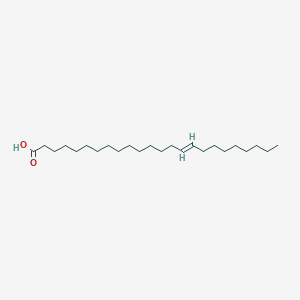| MeSH term | MeSH ID | Detail |
|---|---|---|
| Adrenoleukodystrophy | D000326 | 29 associated lipids |
| Zellweger Syndrome | D015211 | 39 associated lipids |
| Metabolic Syndrome | D024821 | 44 associated lipids |
Trans-selacholeic acid
Trans-selacholeic acid is a lipid of Fatty Acyls (FA) class. Trans-selacholeic acid is associated with abnormalities such as Obesity, Diabetes Mellitus, Non-Insulin-Dependent and Metabolic syndrome. The involved functions are known as Inflammation, Insulin Resistance and Synthesis. The associated genes with Trans-selacholeic acid are TNF gene and CCL2 gene. The related lipids are nervonic acid, palmitoleic acid and Sphingolipids.
Cross Reference
Introduction
To understand associated biological information of Trans-selacholeic acid, we collected biological information of abnormalities, associated pathways, cellular/molecular locations, biological functions, related genes/proteins, lipids and common seen animal/experimental models with organized paragraphs from literatures.
What diseases are associated with Trans-selacholeic acid?
Trans-selacholeic acid is suspected in Obesity, Diabetes Mellitus, Non-Insulin-Dependent, Metabolic syndrome and other diseases in descending order of the highest number of associated sentences.
Related references are mostly published in these journals:
| Disease | Cross reference | Weighted score | Related literature |
|---|
Possible diseases from mapped MeSH terms on references
We collected disease MeSH terms mapped to the references associated with Trans-selacholeic acid
PubChem Associated disorders and diseases
What pathways are associated with Trans-selacholeic acid
There are no associated biomedical information in the current reference collection.
PubChem Biomolecular Interactions and Pathways
Link to PubChem Biomolecular Interactions and PathwaysWhat cellular locations are associated with Trans-selacholeic acid?
There are no associated biomedical information in the current reference collection.
What functions are associated with Trans-selacholeic acid?
Related references are published most in these journals:
| Function | Cross reference | Weighted score | Related literatures |
|---|
What lipids are associated with Trans-selacholeic acid?
Related references are published most in these journals:
| Lipid concept | Cross reference | Weighted score | Related literatures |
|---|
What genes are associated with Trans-selacholeic acid?
Related references are published most in these journals:
| Gene | Cross reference | Weighted score | Related literatures |
|---|
What common seen animal models are associated with Trans-selacholeic acid?
There are no associated biomedical information in the current reference collection.
NCBI Entrez Crosslinks
All references with Trans-selacholeic acid
Download all related citations| Authors | Title | Published | Journal | PubMed Link |
|---|---|---|---|---|
| pmid:27765078 | ||||
| pmid:26858144 | ||||
| pmid:25172358 | ||||
| pmid: | ||||
| Agazzi ME et al. | In-house validation of an improved sample extraction and clean-up method for GC determination of isomers of nervonic acid in meat products. | 2003 | Anal Bioanal Chem | pmid:12732919 |
| Murakami S et al. | Site-directed mutational analysis of structural interactions of low molecule compounds binding to the N-terminal 8 kDa domain of DNA polymerase beta. | 2006 | Biochem. Biophys. Res. Commun. | pmid:16996474 |
| Yang J et al. | Study of the inhibitory effect of fatty acids on the interaction between DNA and polymerase beta. | 2009 | Biochemistry Mosc. | pmid:19747104 |
| Lecerf J | Evidence of accumulation of ceramides containing [14C]nervonic acid in the rat lung following injection of [14C]erucic acid. | 1980 | Biochim. Biophys. Acta | pmid:7370286 |
| Mizushina Y et al. | The inhibitory action of fatty acids on DNA polymerase beta. | 1997 | Biochim. Biophys. Acta | pmid:9367179 |
| Mizushina Y et al. | Mode analysis of binding of fatty acids to mammalian DNA polymerases. | 2000 | Biochim. Biophys. Acta | pmid:10903472 |
| Weidner E and Findley A | Catalase in microsporidian spores before and during discharge. | 2003 | Biol. Bull. | pmid:14583549 |
| Kasai N et al. | Sulfoquinovosylmonoacylglycerol inhibitory mode analysis of rat DNA polymerase beta. | 2005 | FEBS J. | pmid:16128805 |
| Oda E et al. | Relationships between serum unsaturated fatty acids and coronary risk factors: negative relations between nervonic acid and obesity-related risk factors. | 2005 | Int Heart J | pmid:16394593 |
| Impallomeni G et al. | Synthesis and characterization of poly(3-hydroxyalkanoates) from Brassica carinata oil with high content of erucic acid and from very long chain fatty acids. | 2011 | Int. J. Biol. Macromol. | pmid:21035502 |
| Dadras SS et al. | Implication of hydrogen peroxide generation and apoptosis in the neoplastic transformation of mouse fibroblasts overexpressing peroxisomal fatty acyl-CoA oxidase. | 1998 | Int. J. Oncol. | pmid:9454884 |
| Odabasi E et al. | Lipophilic components of different therapeutic mud species. | 2007 | J Altern Complement Med | pmid:18166123 |
| Erkkilä AT et al. | Association between school performance, breast milk intake and fatty acid profile of serum lipids in ten-year-old cleft children. | 2005 | J Craniofac Surg | pmid:16192854 |
| Umemoto H et al. | Fermentative production of nervonic acid by Mortierella capitata RD000969. | 2014 | J Oleo Sci | pmid:24919474 |
| Yamazaki Y et al. | Proportion of nervonic acid in serum lipids is associated with serum plasmalogen levels and metabolic syndrome. | 2014 | J Oleo Sci | pmid:24770479 |
| Shearer GC et al. | Plasma fatty acids in chronic kidney disease: nervonic acid predicts mortality. | 2012 | J Ren Nutr | pmid:21775161 |
